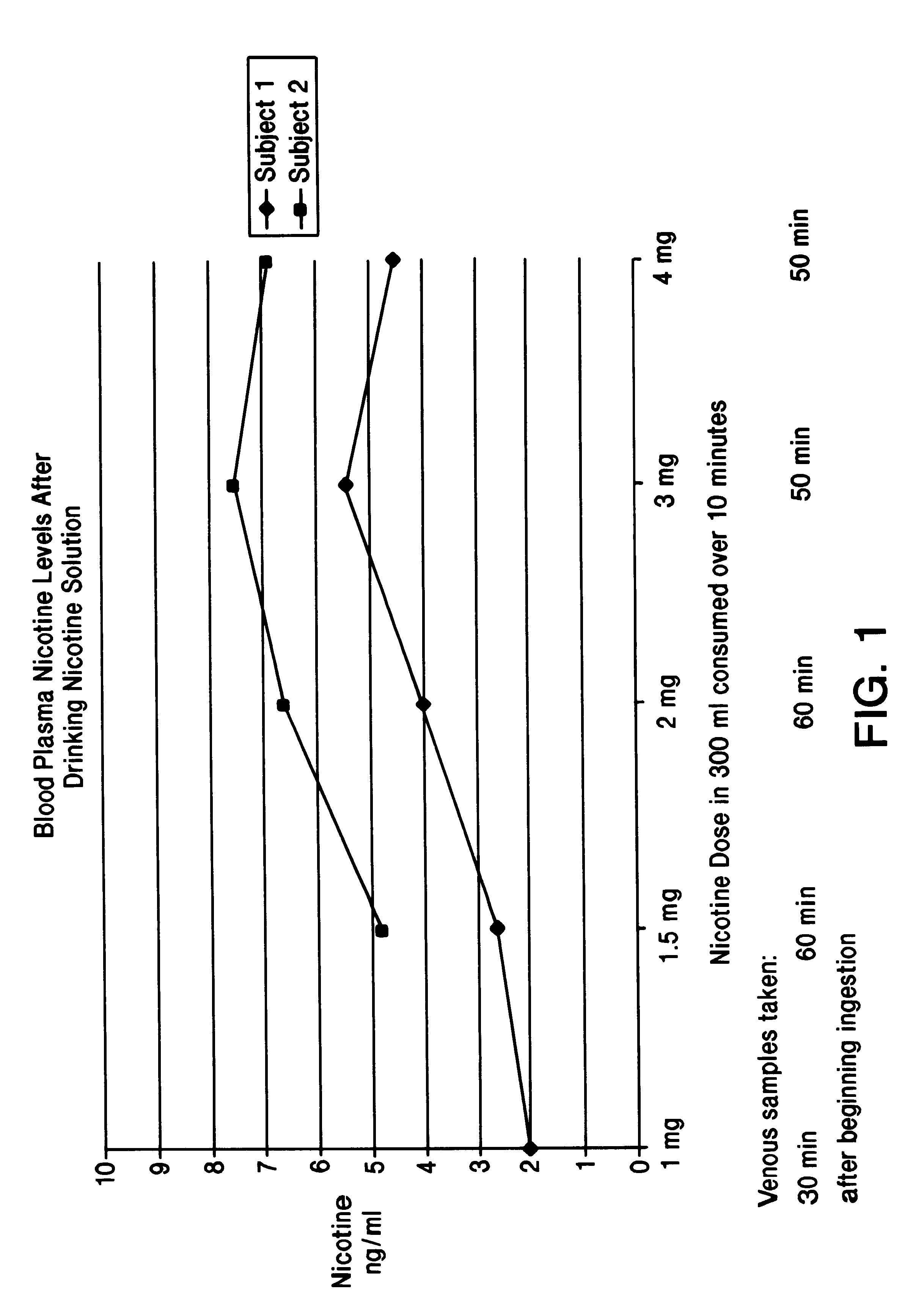Solution containing nicotine
a nicotine and solution technology, applied in the direction of dispersed delivery, drug composition, metabolism disorder, etc., can solve the problems of nicotine aversive bitter taste, nicotine swallowed by drinking a solution would not be an effective way to administer nicotine, and the craving for cigarettes is still nearly 50 million americans, so as to reduce the craving for cigarettes, relieve the craving for tobacco smoking, and reduce the likelihood of cramping
- Summary
- Abstract
- Description
- Claims
- Application Information
AI Technical Summary
Benefits of technology
Problems solved by technology
Method used
Image
Examples
example 1
Part A. To test the efficacy of the instant invention, applicants conducted a controlled laboratory study in which 2 subject non-smokers drank various nicotine solutions. Each sample was prepared by adding the respective amount of levo nicotine (purchased from Kodak), as indicated in the graph in FIG. 1, to an aqueous cola beverage (Diet Coke.RTM.) to make each sample be a total of 300 ml of solution.
Each subject drank 1 drink per day, with each drink being drunk over a time span of 10 minutes. Specifically, on day 1, each subject drank 1 drink containing 1 mg of nicotine; on day 2, each subject drank 1 drink containing 1.5 mg of nicotine; on day 3, each subject drank 1 drink containing 2 mg of nicotine; on day 4, each subject drank 1 drink containing 3 mg of nicotine; and on day 5, each subject drank 1 drink containing 4 mg of nicotine.
All nicotine solutions had a pH of 3.2 that was due to the carbonic acid already present in the cola beverage. The blood plasma levels of the 2 subj...
example 2
Repeated may be Example 1, except with 2 smokers. Smoking will not be permitted during the study, and the subjects will arrive at the laboratory after 24 hours abstinence from smoking (confirmation by expired air carbon monoxide analysis).
Subsequent to the test, the subjects will be asked to rate their craving for cigarettes and other smoking withdrawal symptoms experienced after the drinking of the nicotine solutions. Both subjects should report the craving for cigarettes, as well as withdrawal symptoms, are tending to decrease.
Also subsequent to each drink, the blood plasma levels of the 2 subjects will be tested for nicotine content, and should be similar to those reported in Example 1.
example 3
Repeated may be Example 1, except with 2 persons who have attention deficit disorder. Smoking will not be permitted during the study, and if the subjects are smokers, they will arrive at the laboratory after 24 hours abstinence from smoking (confirmation by expired air carbon monoxide analysis), to ensure nicotine effects are due to the nicotine in the solutions and not to nicotine in smoking tobacco products.
Subsequent to the test, the subjects will be asked to rate their attention deficit disorder symptoms experienced after the drinking of the nicotine solutions. Both subjects should report the symptoms are tending to decrease.
Also subsequent to each drink, the blood plasma levels of the 2 subjects will be tested for nicotine content, and should be similar to those reported in Example 1.
PUM
| Property | Measurement | Unit |
|---|---|---|
| body weight | aaaaa | aaaaa |
| pKa | aaaaa | aaaaa |
| pH | aaaaa | aaaaa |
Abstract
Description
Claims
Application Information
 Login to View More
Login to View More - R&D
- Intellectual Property
- Life Sciences
- Materials
- Tech Scout
- Unparalleled Data Quality
- Higher Quality Content
- 60% Fewer Hallucinations
Browse by: Latest US Patents, China's latest patents, Technical Efficacy Thesaurus, Application Domain, Technology Topic, Popular Technical Reports.
© 2025 PatSnap. All rights reserved.Legal|Privacy policy|Modern Slavery Act Transparency Statement|Sitemap|About US| Contact US: help@patsnap.com


